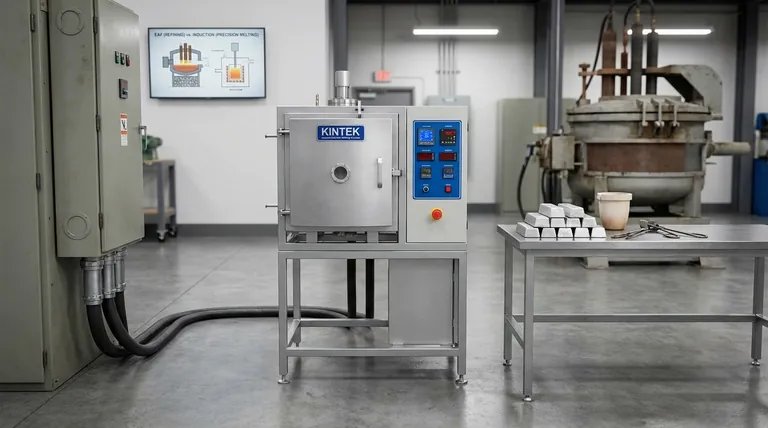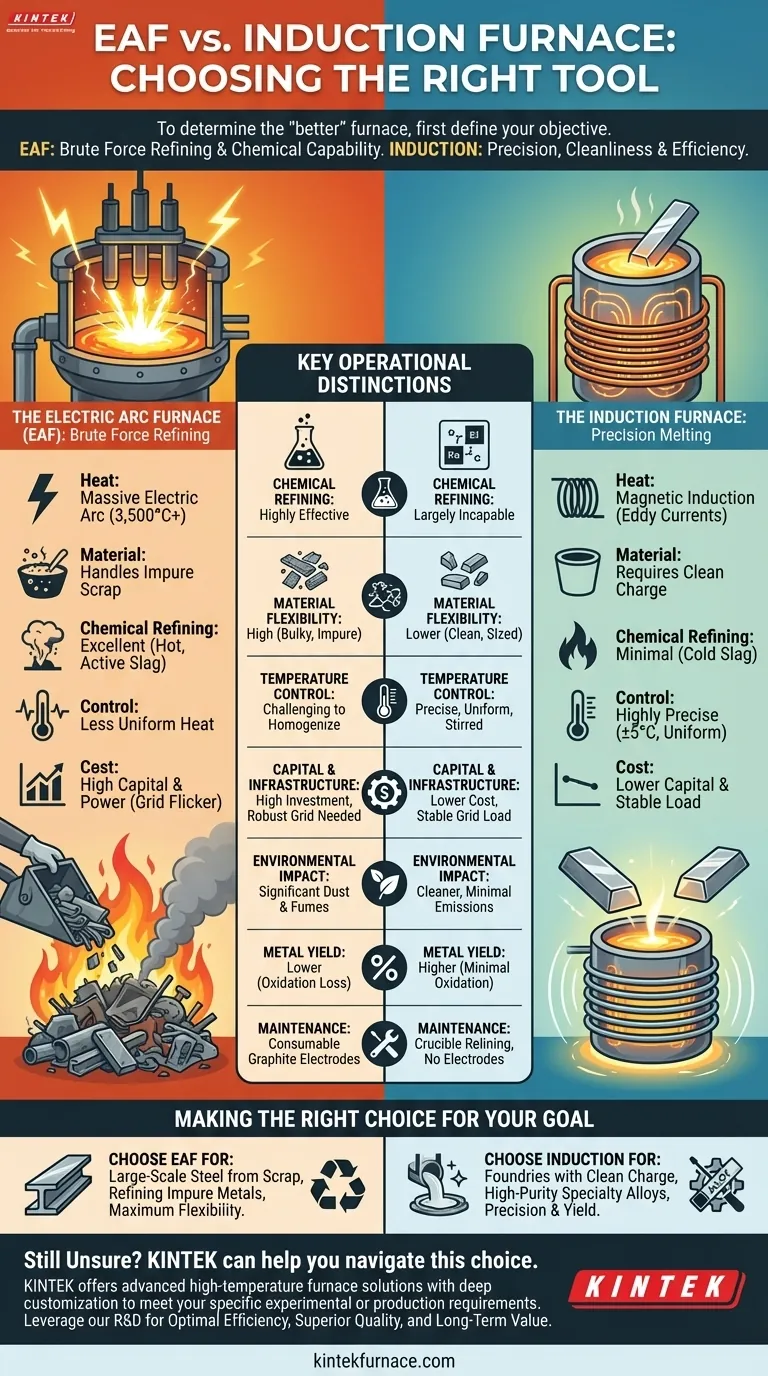To determine the "better" furnace, you must first define your objective. The Electric Arc Furnace (EAF) is fundamentally a refining vessel, designed to handle and purify impure charge materials like steel scrap using extreme heat. In contrast, the induction furnace is a highly efficient melting vessel, ideal for processing clean charge materials or creating alloys where precise chemical and temperature control is paramount. Neither is universally superior; they are different tools for different metallurgical tasks.
The core distinction is simple: choose an Electric Arc Furnace for its raw power and chemical refining capability, especially with scrap steel. Choose an induction furnace for its precision, cleanliness, and efficiency when melting known, clean materials.

The Fundamental Difference: How They Generate Heat
Understanding how each furnace works reveals its inherent strengths and weaknesses. The heating method dictates everything from chemical capability to operational cost.
The Electric Arc Furnace (EAF): Brute Force Refining
An EAF operates by creating a massive electric arc—essentially a controlled lightning strike—between graphite electrodes and the metal charge inside.
This arc generates immense localized temperatures, often exceeding 3,500°C (6,300°F). This intense energy is not just for melting; its primary advantage is creating an extremely hot, chemically active layer of slag that floats on top of the molten metal.
The Induction Furnace: Precision Melting
An induction furnace works without an arc or external heat source. Instead, it uses a powerful alternating current passed through a coil that surrounds a crucible containing the metal.
This creates a strong magnetic field that induces powerful eddy currents within the metal itself, causing it to heat rapidly and uniformly from the inside out. This process is clean, contained, and highly controllable.
Key Operational Distinctions
The differences in heating mechanisms lead to profound differences in how these furnaces operate and what they can achieve.
Chemical Refining Capability
This is the most critical differentiator. The EAF's hot arc actively heats the slag, making it highly effective at removing impurities like phosphorus and sulfur from the steel melt. This is why EAFs dominate the scrap steel recycling industry.
Induction furnaces, by contrast, have a "cold" slag layer. The slag is only heated by contact with the molten metal beneath it, making it far less chemically reactive and largely incapable of significant refining.
Material Input Flexibility
EAFs are robust and can handle a wide variety of charge materials, including large, bulky, and lower-purity scrap metal. The intense power of the arc can effectively melt almost any conductive material you put inside.
Induction furnaces are more sensitive. They require cleaner, more appropriately sized charge materials to operate efficiently and avoid damage to the crucible lining.
Temperature and Control
The EAF's arc is incredibly hot, but this heat is not uniform. While excellent for driving chemical reactions, achieving precise, homogenous temperature control throughout the entire melt can be challenging.
Induction furnaces provide exceptionally uniform heating and precise temperature control (often within ±5°C). The electromagnetic forces also create a natural stirring action, ensuring the melt is homogenous. This makes them ideal for producing high-quality alloys with very tight specifications.
Understanding the Trade-offs
Choosing a furnace technology involves a careful analysis of both operational and economic factors.
Cost and Infrastructure
EAFs represent a major capital investment and require an extremely robust electrical infrastructure to handle the massive, fluctuating power draws that can cause "flicker" on the local grid. They also have a significant ongoing cost in the consumption of graphite electrodes.
Induction furnaces generally have a lower capital cost, especially for smaller units, and present a more stable, predictable load to the power grid.
Environmental Impact and Yield
EAFs are loud and produce significant dust and fumes that require extensive and expensive environmental control systems. They can also have a lower metal yield due to oxidation caused by the high temperatures of the arc.
Induction furnaces are much quieter and cleaner, producing very little dust or direct emissions. Because the heating is contained within the metal, metal loss to oxidation is minimal, resulting in higher yields.
Maintenance
The primary maintenance consumable for an EAF is the graphite electrodes, which are continuously consumed during operation. The furnace refractory also requires regular maintenance.
For an induction furnace, the main maintenance concern is the periodic relining of the crucible (refractory). There are no electrode costs.
Making the Right Choice for Your Goal
Your choice should be dictated entirely by your input materials and desired output.
- If your primary focus is large-scale steel production from scrap: The EAF is the unmatched industry standard due to its superior refining capability and ability to handle diverse scrap qualities.
- If your primary focus is operating a foundry with clean scrap or pre-alloyed ingots: An induction furnace is more energy-efficient, provides better yield, and offers the precise control needed for high-quality castings.
- If your primary focus is producing high-purity specialty alloys or superalloys: An induction furnace's clean melting and precise temperature control are essential for meeting strict chemical specifications.
- If your primary focus is maximum flexibility to process both clean and impure metals: The EAF provides the operational latitude to handle a wider range of input materials, though it comes at a higher operational cost.
Ultimately, selecting the right furnace is about aligning the technology's core strengths with your specific metallurgical mission.
Summary Table:
| Feature | Electric Arc Furnace (EAF) | Induction Furnace |
|---|---|---|
| Primary Use | Refining impure metals (e.g., scrap steel) | Melting clean materials & precise alloying |
| Heat Source | High-temperature electric arc | Magnetic induction (eddy currents) |
| Chemical Refining | Excellent (hot, active slag) | Minimal (cold slag) |
| Temperature Control | Less uniform | Highly precise and uniform |
| Material Flexibility | High (handles bulky, impure scrap) | Lower (requires clean, sized charge) |
| Metal Yield | Lower (oxidation loss) | Higher (minimal oxidation) |
| Capital Cost | High (large-scale) | Lower (especially for smaller units) |
Still Unsure Which Furnace is Right for Your Application?
Choosing between an induction furnace and an electric arc furnace is a critical decision that impacts your product quality, operational efficiency, and bottom line. You don't have to make it alone.
KINTEK can help you navigate this choice and deliver a solution tailored to your unique needs. Leveraging our exceptional R&D and in-house manufacturing, we provide diverse laboratories and foundries with advanced high-temperature furnace solutions. Our product line, including Muffle, Tube, and Rotary Furnaces, is complemented by our strong deep customization capability to precisely meet your specific experimental or production requirements.
Let us help you achieve:
- Optimal Efficiency: Maximize your metal yield and minimize energy costs.
- Superior Quality: Ensure precise chemical and temperature control for high-purity alloys and castings.
- Long-Term Value: Benefit from a robust solution designed for your exact materials and processes.
Contact our experts today for a personalized consultation. We'll work with you to analyze your goals and recommend the perfect furnace technology to advance your metallurgical mission.
Visual Guide

Related Products
- Vacuum Induction Melting Furnace and Arc Melting Furnace
- 1700℃ High Temperature Laboratory Tube Furnace with Quartz or Alumina Tube
- 1700℃ Controlled Inert Nitrogen Atmosphere Furnace
- 1200℃ Controlled Inert Nitrogen Atmosphere Furnace
- 1400℃ Controlled Inert Nitrogen Atmosphere Furnace
People Also Ask
- What are the main industrial applications of vacuum melting furnaces? Achieve Unmatched Material Purity and Performance
- What are the key features and benefits of a Vacuum Induction Melting Furnace? Achieve High-Purity Metal Production
- What are the key benefits of using vacuum melting furnaces? Achieve Superior Purity and Control for High-Performance Alloys
- What are the advantages of vacuum induction melting? Achieve Superior Purity for High-Performance Alloys
- What are the key components of a Vacuum Induction Melting (VIM) furnace? Master High-Purity Metal Processing



















